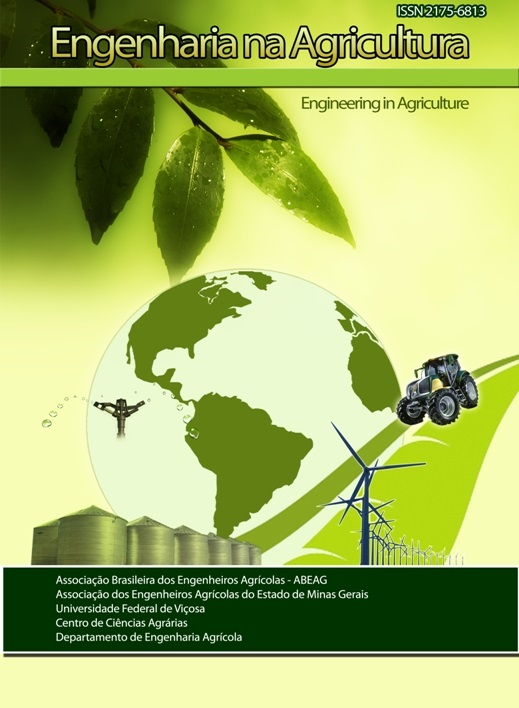Physiological changes in wheat seeds during the artificial drying process
DOI:
https://doi.org/10.13083/reveng.v29i1.8138Palavras-chave:
germination, emergence, Triticum aestivum L., vigor, moisture contentResumo
The desiccation tolerance presented by orthodox species is a characteristic that allows the loss of water keeping the seed viable. However, the reduction of the moisture content by drying, has a critical limit, and a loss beyond this limit results in a reduction in the physiological quality of the seeds, TBIO Sossego cultivar. The objective of this study was to evaluate the physiological changes resulting from the reduction of moisture percentage in the artificial drying process of wheat seeds. The seeds used were of the cultivar TBIO Sossego with initial water content of 14.7%. The seeds were dried at 40 ± 2 °C until reaching 12, 10 and 8% moisture. The evaluated variables were germination, seedling length, electrical conductivity, field emergence, shoot length and root length. Drying of wheat seeds can be performed up to 8% moisture without affecting the physiological quality of the seeds.
Downloads
Referências
BEWLEY, J.D.; BRAFORD, K.J.; HILHORST, H.W.M.; NONOGAKI, H. Seeds: Physiology of development, germination and dormancy. 3ª ed. New York: Springer, 2013, 392p.
BRASIL. Ministério da Agricultura, Pecuária e Abastecimento. Regras para análise de sementes (RAS). Brasília: MAPA/ACS, 2009, 395p.
CARLESSO, V.O.; BERBERT, P.A.; SILVA, R.F.; DETMANN, E. Secagem e armazenamento de sementes de maracujá amarelo (Passiflora edulis Sims f. flavicarpa Degener). Revista Brasileira de Sementes, v.30, n.2, p.65-74, 2008.
CONAB. Acompanhamento da safra brasileira: grãos. Companhia nacional de abastecimento. SAFRA 2018/19, Quarto levantamento, v.6, n.4, p.1-145, Brasília, janeiro de 2019. Available at: <https://www.conab.gov.br/info-agro/safras/ grains>. Accessed on March 5, 2019.
DELIBERALI, J.; OLIVEIRA, M.; DURIGON, A.; DIAS, A.R.G.; GUTKOSKI, L.C.; ELIAS, M.C. Efeitos de processo de secagem e tempo de armazenamento na qualidade tecnológica de trigo. Ciência e Agrotecnologia, Lavras, v.34, n.5, p.1285-1292, 2010.
EICHELBERGER, L. Produção de sementes de trigo. In: PIRES, J.L.F; VARGAS, L; CUNHA, G.R. (eds.). Trigo no Brasil: bases para produção competitiva e sustentável. Embrapa Trigo, Passo Fundo, 2011, p.349-370.
ELLIS, R. H.; HONG, T. D. Temperature sensitivity of the low-moisture content limit to negative seed longevity moisture content relationships in hermetic storage. Annals of Botany, Rennes, v.97, n.5, p.785-791, 2006.
HARTMANN-FILHO, C.P.; GONELI, A.L.D.; MASETTO, T.E.; MARTINS, E.A.S.; OBA, G.C. The effect of drying temperatures and storage of seeds on the growth of soybean seedlings. Journal of Seed Science, Londrina, v.38, n.4, p.287-295, 2016.
HONG, T.D.; ELLIS, R.H.; ASTLEY, D.; PINNEGAR, A.E.; GROOT, S.P.C.; KRAAK, H.L. Survival and vigour of ultra-dry seeds after ten years of hermetic storage. Seed Science and Technology, v.33, n.2, p.449-460, 2005.
JOSÉ. S.C.B.R.; SALOMÃO, A.N.; MUNDIN, R.C.; PÁDUA, J.G. Umidificação de sementes de girassol após ultrassecagem em sílica gel e câmara de secagem. Revista Brasileira de Sementes, Londrina, v.31, n.3, p.16-26, 2009.
MARCOS-FILHO, J. Fisiologia de sementes de plantas cultivadas. Londrina: ABRATES, 2015. 660p.
MIRA, S.; ESTRELLES, E.; GONZALEZ-BENITO, M.E. Effect of water content and temperature on seed longevity of seven Brassicaceae species after 5 years storage. Plant Biology, Stuttgart, v.17, p.153-162, 2015.
NAKAGAWA, J. Testes de vigor baseados no desempenho das plântulas. In: KRZYZANOWSKI, F. C.; VIEIRA, R. D.; FRANÇA NETO, J. B. (Ed.). Vigor de sementes: conceitos e testes. Londrina: ABRATES, 1999. cap.2, p.1-24.
OLIVEIRA, C.F.; OLIVEIRA, D.C.; PARISI, J.J.; BARBEDO, C.J. Deterioração de sementes de espécies brasileiras de Eugenia em função da incidência e do controle de fungos. Revista Brasileira de Sementes, Londrina, v.33, n.3, 2011.
OLIVEIRA, D.E.C.; RESENDE, O.; SMANIOTTO, T.A.S.; CAMPOS, R.C. Qualidade fisiológica de sementes de milho submetidas a diferentes temperaturas na secagem artificial. Global Science and Technology, Rio Verde, v.9, n.2, p.25-34, 2016.
PESKE, S. T.; VILLELA, F. A.; MENEGHELLO, G. E. Sementes: Fundamentos científicos e tecnológicos. Pelotas: Becker e Peske, 2019. 579 p.
PRADO, M. E. T.; ALONSO, L. F. T.; PARK, K. J. Shrinkage of dates (Phoenix dacyilyfera L.) during drying. Drying Technology, New York, v.18, n.1 e 2, p.295-310, 2000.
Downloads
Publicado
Como Citar
Edição
Seção
Licença
Copyright (c) 2020 REVISTA ENGENHARIA NA AGRICULTURA - REVENG

Este trabalho está licenciado sob uma licença Creative Commons Attribution-NonCommercial 4.0 International License.
Autores que publicam nesta revista concordam com os seguintes termos:
O(s) autor(es) autoriza(m) a publicação do texto na da revista;
O(s) autor(es) garantem que a contribuição é original e inédita e que não está em processo de avaliação em outra(s) revista(s);
A revista não se responsabiliza pelas opiniões, ideias e conceitos emitidos nos textos, por serem de inteira responsabilidade de seu(s) autor(es);
É reservado aos editores o direito de proceder a ajustes textuais e de adequação às normas da publicação.
A partir da submissão, o autor estará cedendo integralmente seus direitos patrimoniais da obra à publicação, permanecendo detentor de seus direitos morais (autoria e identificação na obra) e de acordo com a Licença Creative Commons, CC BY-NC.








 Esta obra está licenciada com uma Licença
Esta obra está licenciada com uma Licença 